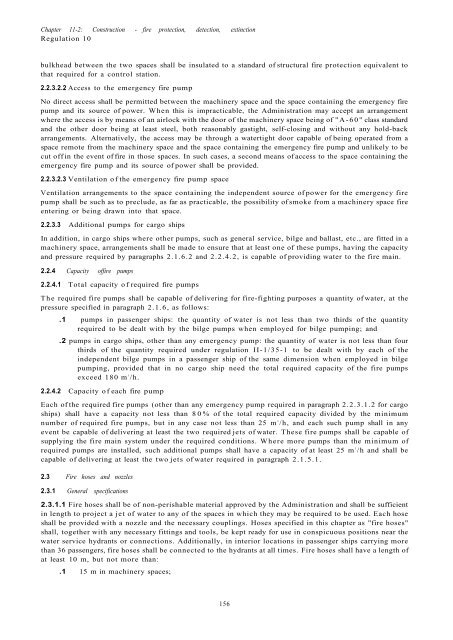Solas Consolidated Edition 2009.pdf
Solas Consolidated Edition 2009 for maritime
Solas Consolidated Edition 2009 for maritime
Create successful ePaper yourself
Turn your PDF publications into a flip-book with our unique Google optimized e-Paper software.
Chapter 11-2: Construction - fire protection, detection, extinction<br />
Regulation 10<br />
bulkhead between the two spaces shall be insulated to a standard of structural fire protection equivalent to<br />
that required for a control station.<br />
2.2.3.2.2 Access to the emergency fire pump<br />
No direct access shall be permitted between the machinery space and the space containing the emergency fire<br />
pump and its source of power. When this is impracticable, the Administration may accept an arrangement<br />
where the access is by means of an airlock with the door of the machinery space being of "A-60" class standard<br />
and the other door being at least steel, both reasonably gastight, self-closing and without any hold-back<br />
arrangements. Alternatively, the access may be through a watertight door capable of being operated from a<br />
space remote from the machinery space and the space containing the emergency fire pump and unlikely to be<br />
cut off in the event of fire in those spaces. In such cases, a second means of access to the space containing the<br />
emergency fire pump and its source of power shall be provided.<br />
2.2.3.2.3 Ventilation of the emergency fire pump space<br />
Ventilation arrangements to the space containing the independent source of power for the emergency fire<br />
pump shall be such as to preclude, as far as practicable, the possibility of smoke from a machinery space fire<br />
entering or being drawn into that space.<br />
2.2.3.3 Additional pumps for cargo ships<br />
In addition, in cargo ships where other pumps, such as general service, bilge and ballast, etc., are fitted in a<br />
machinery space, arrangements shall be made to ensure that at least one of these pumps, having the capacity<br />
and pressure required by paragraphs 2.1.6.2 and 2.2.4.2, is capable of providing water to the fire main.<br />
2.2.4 Capacity offire pumps<br />
2.2.4.1 Total capacity of required fire pumps<br />
The required fire pumps shall be capable of delivering for fire-fighting purposes a quantity of water, at the<br />
pressure specified in paragraph 2.1.6, as follows:<br />
.1 pumps in passenger ships: the quantity of water is not less than two thirds of the quantity<br />
required to be dealt with by the bilge pumps when employed for bilge pumping; and<br />
.2 pumps in cargo ships, other than any emergency pump: the quantity of water is not less than four<br />
thirds of the quantity required under regulation II-1/35-1 to be dealt with by each of the<br />
independent bilge pumps in a passenger ship of the same dimension when employed in bilge<br />
pumping, provided that in no cargo ship need the total required capacity of the fire pumps<br />
exceed 180 m 3 /h.<br />
2.2.4.2 Capacity of each fire pump<br />
Each of the required fire pumps (other than any emergency pump required in paragraph 2.2.3.1.2 for cargo<br />
ships) shall have a capacity not less than 80% of the total required capacity divided by the minimum<br />
number of required fire pumps, but in any case not less than 25 m 3 /h, and each such pump shall in any<br />
event be capable of delivering at least the two required jets of water. These fire pumps shall be capable of<br />
supplying the fire main system under the required conditions. Where more pumps than the minimum of<br />
required pumps are installed, such additional pumps shall have a capacity of at least 25 m 3 /h and shall be<br />
capable of delivering at least the two jets of water required in paragraph 2.1.5.1.<br />
2.3 Fire hoses and nozzles<br />
2.3.1 General specifications<br />
2.3.1.1 Fire hoses shall be of non-perishable material approved by the Administration and shall be sufficient<br />
in length to project a jet of water to any of the spaces in which they may be required to be used. Each hose<br />
shall be provided with a nozzle and the necessary couplings. Hoses specified in this chapter as "fire hoses"<br />
shall, together with any necessary fittings and tools, be kept ready for use in conspicuous positions near the<br />
water service hydrants or connections. Additionally, in interior locations in passenger ships carrying more<br />
than 36 passengers, fire hoses shall be connected to the hydrants at all times. Fire hoses shall have a length of<br />
at least 10 m, but not more than:<br />
.1 15 m in machinery spaces;<br />
156


